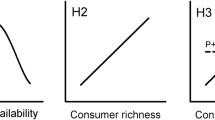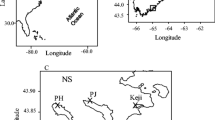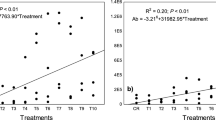Abstract
Changing environments can have divergent effects on biodiversity–ecosystem function relationships at alternating trophic levels. Freshwater mussels fertilize stream foodwebs through nutrient excretion, and mussel species-specific excretion rates depend on environmental conditions. We asked how differences in mussel diversity in varying environments influence the dynamics between primary producers and consumers. We conducted field experiments manipulating mussel richness under summer (low flow, high temperature) and fall (moderate flow and temperature) conditions, measured nutrient limitation, algal biomass and grazing chironomid abundance, and analyzed the data with non-transgressive overyielding and tripartite biodiversity partitioning analyses. Algal biomass and chironomid abundance were best explained by trait-independent complementarity among mussel species, but the relationship between biodiversity effects across trophic levels (algae and grazers) depended on seasonal differences in mussel species’ trait expression (nutrient excretion and activity level). Both species identity and overall diversity effects were related to the magnitude of nutrient limitation. Our results demonstrate that biodiversity of a resource-provisioning (nutrients and habitat) group of species influences foodweb dynamics and that understanding species traits and environmental context are important for interpreting biodiversity experiments.







Similar content being viewed by others
References
Ackerly DD, Cornwell WK (2007) A trait-based approach to community assembly: partitioning of species trait values into within- and among-community components. Ecol Lett 10:135–145
Allen DC, Vaughn CC (2009) Burrowing behavior of freshwater mussels in experimentally manipulated communities. J North Am Benthol Soc 28:93–100
ASTM (1995) Standard methods for the examination of water and wastewater. American Public Health Association/American Water Works Association/Water Environment Federation, Alexandria
Borer ET, Seabloom EW, Shurin JB, Anderson KE, Blanchette CA, Broitman B, Cooper SD, Halper BS (2005) What determines the strength of a trophic cascade? Ecology 86:528–537
Canuel EA, Spivak AC, Waterson EJ, Duffy JE (2007) Biodiversity and food web structure influence short-term accumulation of sediment organic matter in an experimental seagrass system. Limnol Oceanogr 52:590–602
Cardinale BJ, Nelson K, Palmer MA (2000) Linking species diversity to the functioning of ecosystems: on the importance of environmental context. Oikos 9:175–183
Cardinale BJ (2011) Biodiversity improves water quality through niche partitioning. Nature 472:86–89
Cardinale BJ, Palmer MA, Collins SL (2002) Species diversity enhances ecosystem functioning through interspecific facilitation. Nature 414:427–429
Cardinale BJ, Svristava DS, Duffy JE, Wright JP, Downing AL, Sankaran M, Jouseau JC (2006) Effects of diversity on the functioning of trophic groups and ecosystems. Nature 443:991–992
Diaz S, Boy-Meir I, Cabido M (2001) Can grazing response of herbaceous plants be predicted from simple vegetative traits? J Appl Ecol 38:497–508
Douglass JG, Duffy JE, Bruno JF (2008) Herbivore and predator diversity interactively affect ecosystem properties in an experimental marine community. Ecol Lett 11:598–608
Duffy JE (2003) Biodiversity loss, trophic skew and ecosystem functioning. Ecol Lett 6:680–687
Duffy JE, Cardinale BJ, France KE, McIntyre PB, Thebault E, Loreau M (2007) The functional role of biodiversity in ecosystems: incorporating trophic complexity. Ecol Lett 10:522–538
Duffy JE, Richardson PJ, Canuel EA (2003) Grazer diversity effects on ecosystem functioning in seagrass beds. Ecol Lett 6:637–645
Dyer LA, Letourneau D (2003) Top-down and bottom-up diversity cascades in detrital vs. living food webs. Ecol Lett 6:60–68
Elser JJ, Bracken MES, Cleland EE, Gruner DS, Harpole WS, Hillebrand H, Ngai JT, Seabloom EW, Shurin JB, Smith JE (2007) Global analysis of nitrogen and phosphorus limitation of primary producers in freshwater, marine, and terrestrial ecosystems. Ecol Lett 10:1–8
Evans-White MA, Lamberti GA (2005) Grazer species effects on epilithon nutrient composition. Freshw Biol 50:1853–1863
Finke DL, Denno RF (2005) Predator diversity and the functioning of ecosystems: the role of intraguild predation in dampening trophic cascades. Ecol Lett 8:1299–1306
Fox JW (2005) Interpreting the selection effect of biodiversity on ecosystem function. Ecol Lett 8:846–856
Galbraith HS, Spooner DE, Vaughn CC (2008) Status of rare and endangered freshwater mussels in southeastern Oklahoma rivers. Southwest Nat 5:45–50
Galbraith HS, Spooner DE, Vaughn CC (2010) Synergistic effects of regional climate patterns and local water management on freshwater mussel communities. Biol Conserv 143:1175–1183
Gessner MO, Swan CM, McKie BG, Bardgett RD, Wall DH, Hättenschwiler S (2010) Diversity meets decomposition. Trends Ecol Evol 25:372–380
Gresens SE (1995) Grazer diversity, competition and the response of the periphyton community. Oikos 73:336–346
Griffin JN, De La Haye KL, Hawkins SJ, Thompson RC, Jenkins SR (2008) Predator diversity and ecosystem functioning: density modifies the effect of resource partitioning. Ecology 89:298–305
Hairston NG, Smith FE, Slobodkin LB (1960) Community structure, population control, and competition. Am Nat 94:421–425
Hillebrand H, Cardinale BJ (2004) Consumer effects decline with prey diversity. Ecol Lett 7:192–201
Hillebrand H, de Montpellier G, Liess A (2004) Effects of macrograzers and light on periphyton stoichiometry. Oikos 106:93–104
Hillebrand H, Matthiessen B (2009) Biodiversity in a complex world: consolidation and progress in functional biodiversity research. Ecol Lett 12:1405–1419
Hillebrand H, Shurin JB (2005) Biodiversity and aquatic food webs. In: Belgrano A, Scharler UM, Dunne J, Ulanowicz RE (eds) Aquatic food webs–an ecosystem approach. Oxford University Press, Oxford, pp 184–197
Hillebrand H, Gruner DS, Borer ET, Bracken MES, Cleland EE, Elser JJ, Harpole WS, Ngai JT, Seabloom EW, Shurin JB, Smith JE (2007) Consumer versus resource control of producer diversity depends on ecosystem type and producer community structure. Proc Natl Acad Sci USA 104:10904–10909
Hooper DU (1998) The role of complementarity and competition in ecosystem responses to variation in plant diversity. Ecology 79:704–719
Hunter MD, Price PW (1992) Playing chutes and ladders: heterogeneity and the relative roles of bottom–up and top–down forces in natural communities. Ecology 73:724–732
Kahmen A, Renker C, Unsicker SB, Buchmann N (2006) Niche complementarity for nitrogen: an explanation for the biodiversity and ecosystem function relationship. Ecology 87:1244–1255
Kominoski JS, Hoellin TJ, Leroy CJ, Pringle CM, Swan CM (2010) Beyond species richness: expanding biodiversity-ecosystem functioning theory in detritus-based streams. Rivers Res Appl 26:67–75
Leibold MA, Chase JM, Shurin JB, Downing AL (1997) Species turnover and the regulation of trophic structure. Annu Rev Ecol Syst 28:467–494
Loreau M (1998) Separating sampling and other effects in biodiversity experiments. Oikos 82:600–602
Loreau M, Hector A (2001) Partitioning selection and complementarity in biodiversity experiments. Nature 412:72–76
Loreau M, Naeem S, Inchausti P, Bengtsson J, Grime JP, Hector A, Hooper DU, Huston MA, Raffaelli D, Schmid B, Tilman D, Wardle DA (2001) Biodiversity and ecosystem functioning: current knowledge and future challenges. Science 294:804–808
Matthews WJ, Vaughn CC, Gido KB, Marsh-Matthews E (2005) Southern Plains Rivers. In: Benke AC, Cushing CE (eds) Rivers of North America. Elsevier, London, pp 283–325
McGill BJ, Enquist BJ, Weiher E, Westoby M (2006) Rebuilding community ecology from functional traits. Trends Ecol Evol 21:178–185
McIntyre PB, Flecker AS, Vanni MJ, Hood JM, Taylor BW, Thomas SA (2008) Fish distributions and nutrient cycling in streams: can fish create biogeochemical hotspots? Ecology 89:2335–2346
Naeem S, Wright JP (2003) Disentangling biodiversity effects on ecosystem functioning: deriving solutions to a seemingly insurmountable problem. Ecol Lett 6:567–579
Naeem S, Thompson LJ, Lawton JH, Woodfin RM (1994) Declining biodiversity can alter the performance of ecosystems. Nature 368:734–736
Poff NL (1997) Landscape filters and species traits: towards mechanistic understanding and prediction in stream ecology. J North Am Benthol Soc 16:391–409
Polis GA, Strong DR (1996) Food web complexity and community dynamics. Am Nat 147:813–845
Pringle CM, Triska FJ (1996) Effects of nutrient enrichment on periphyton. In: Hauer FR, Lamberti GA (eds) Methods in stream ecology. Academic Press, San Diego, pp 607–623
Rosemond AD, Pringle CM, Ramirez A, Paul MJ (2001) A test of top–down and bottom–up control in a detritus-based food web. Ecology 82:2279–2293
Schmid B, Hector A, Huston MA, Inchausti P, Nijs I, Leadley PW, Tilman D (2002) The design and analysis of biodiversity experiments. In: Loreau N, Naeem NS, Inchausti P (eds) Biodiversity and ecosystem functioning: synthesis and perspectives. Oxford University Press, Oxford, pp 61–75
Schmitz OJ, Krivan V, Ovadia O (2004) Trophic cascades: the primacy of trait-mediated indirect interactions. Ecol Lett 7:153–163
Spivak AC, Canuel EA, Duffy JE, Richardson JP (2007) Top–down and bottom–up controls on sediment organic matter composition in an experimental seagrass ecosystem. Limnol Oceanogr 52:2595–2607
Spooner DE, Vaughn CC (2006) Context-dependent effects of freshwater mussels on the benthic community. Freshw Biol 5:1016–1024 Corrigendum 1188
Spooner DE, Vaughn CC (2008) A trait-based approach to species’ roles in stream ecosystems: climate change, community structure, and material cycling. Oecologia 158:307–317
Spooner DE, Vaughn CC (2011) Species’ traits, dominance, and environmental gradients interact to govern primary production in freshwater mussel communities. Oikos (in press). doi:10.1111/j.1600-0706.2011.19380.x
Srivastava DS, Bell T (2009) Reducing horizontal and vertical diversity in a foodweb triggers extinctions and impacts functions. Ecol Lett 12:1016–1028
Srivastava DS, Cardinale BJ, Downing AL, Duffy JE, Jouseau C, Sankaran M, Wright JP (2009) Diversity has stronger top–down than bottom–up effects on decomposition. Ecology 90:1073–1083
Symstad AJ, Tilman D, Wilson J, Knops JMH (1998) Species loss and ecosystem functioning: effects of species identity and community composition. Oikos 81:389–397
Tilman D (1994) Competition and biodiversity in spatially structured habitats. Ecology 75:2–16
Tilman D, Reich PB, Knops J, Wedin D, Mielke T, Lehman C (2001) Diversity and productivity in a long-term grassland experiment. Science 294:843–845
Vaughn CC, Spooner DE, Galbraith HS (2007) Context-dependent species identity effects within a functional group of filter-feeding bivalves. Ecology 88:1654–1662
Vaughn CC, Nichols SJ, Spooner DE (2008) Community and foodweb ecology of freshwater mussels. J North Am Benthol Soc 27:41–55
Vitousek PM, Mooney HA, Lubchenco J, Melillo JM (1997) Human domination of earth’s ecosystems. Science 277:494–499
Walker BH (1992) Biodiversity and ecological redundancy. Conserv Biol 6:18–23
Worm B, Duffy JE (2003) Biodiversity, productivity and stability in real food webs. Trends Ecol Evol 18:629–632
Worm B, Barbier EB, Beaumont N, Duffy JE, Folke C, Halpern BS, Selkow KA, Stachowicz JJ, Watson R (2006) Impacts of biodiversity loss on ocean ecosystem services. Science 314:787–790
Acknowledgments
We thank T. Garrett for allowing access to the field site, R. Deaton, S. and B. Dengler, D. Fenolio, S. Frazier, P. Jeyasingh, M. Jones, S. Jones, F. March, K. Reagan, R. Remington, and E. Webber for field and/or laboratory assistance, and D. Allen for comments on the manuscript. This study was funded by the National Science Foundation (DEB-0211010) and is a contribution to the program of the Oklahoma Biological Survey.
Author information
Authors and Affiliations
Corresponding author
Additional information
Communicated by Jonathan Shurin.
Rights and permissions
About this article
Cite this article
Spooner, D.E., Vaughn, C.C. & Galbraith, H.S. Species traits and environmental conditions govern the relationship between biodiversity effects across trophic levels. Oecologia 168, 533–548 (2012). https://doi.org/10.1007/s00442-011-2110-1
Received:
Accepted:
Published:
Issue Date:
DOI: https://doi.org/10.1007/s00442-011-2110-1




